This blog post is one of six keynotes by NGINX team members from nginx.conf 2017. Together, these blog posts introduce the NGINX Application Platform, new products, and product and strategy updates.
The blog posts are:
- This post: Keynote on “Speeding Innovation”, Gus Robertson (video here)
- NGINX Product Roadmap, Owen Garrett (video here)
- Introducing NGINX Controller, Chris Stetson and Rachael Passov (video here)
- Introducing NGINX Unit, Igor Sysoev and Nick Shadrin (video here, in‑depth demo here, integration with the OpenShift Service Catalog here)
- The Future of Open Source at NGINX, Ed Robinson and Owen Garrett (video here)
- NGINX Amplify is Generally Available, Owen Garrett (video here)
You may also wish to view the conference video playlist on the NGINX YouTube Channel.
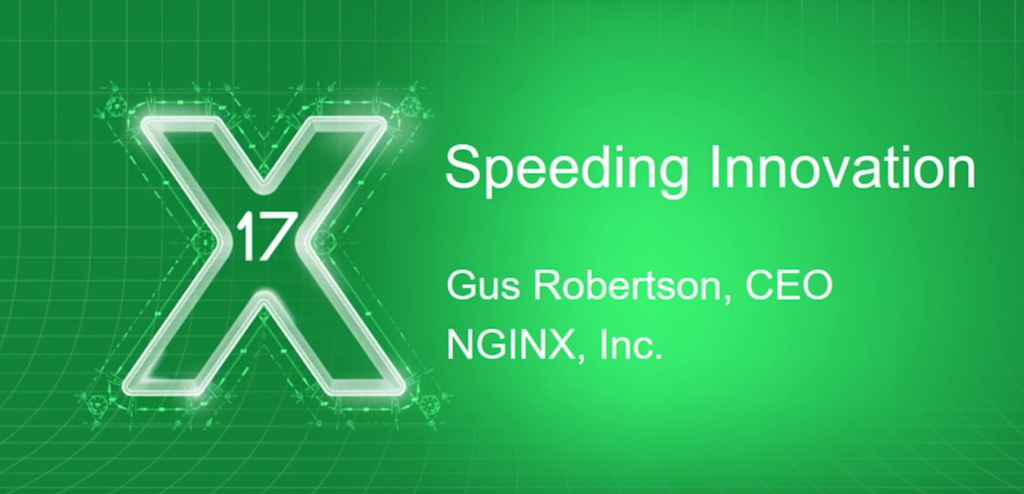
Welcome to Portland. It’s fantastic to have you all here. I want to thank you all for coming and making the effort to come up to Portland, if you’re not from Portland. I want to thank, of course, the sponsors who are all outside in the booths.
A particular thanks to Red Hat. Many of you probably know that I used to work for Red Hat. It’s great to have their support and have their sponsorship here, as well as all the other sponsors, and for the staff. I want to thank our staff for putting this together.
This is actually our fourth annual user conference. Can I ask how many of you in the audience were here with us in Austin last year? Show your hands. Wow, okay, a few of you. Well, a lot’s happened since we were together in Austin. Let’s just have a little look at what’s happened, right?
S3 had an outage in the last 12 months that affected a lot of people – probably many of you here in the room. A major controversy surrounding Uber resulting, eventually, in the CEO leaving the company.
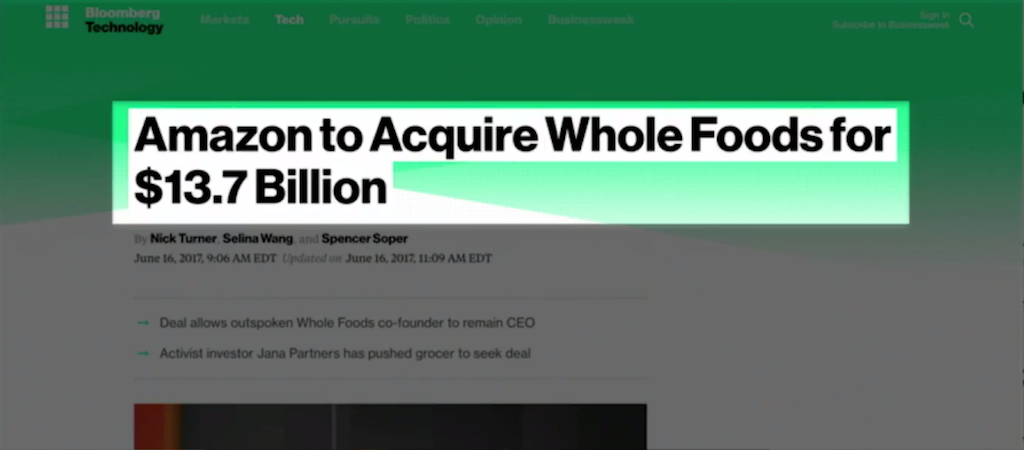
Some major acquisitions have happened, sending some shockwaves through different industries. We’re seeing new companies formed that are going after the final frontier, which is incredibly exciting – sometimes being successful, sometimes less so. Here in the US, we elected a new Tweeter‑in‑Chief, and the UK has decided, in Europe, to go it alone.
And probably the most important thing and most impactful thing is: there’s a new season of Silicon Valley that’s out. And we actually have Jimmy O. Yang here at nginx.conf. He’ll be the keynote speaker closing off the event tomorrow, so please mark that down in your calendar.
![]()
So what does all this mean, all that’s happened in the last few months? Well, the reality is: I don’t know, but it sure does make life interesting, doesn’t it? Keeps us on our toes. What I wanted to do, today, though, is go back and take you on a journey. To look at what’s happened over the last, roughly, ten years, and share with you four successful models we’ve seen to handle these disruptive times that we’re in, the bumps in the road that you’re potentially going to face along the way, and hopefully how NGINX can help you through this period.
A Decade of Disruptors
So let’s start the journey now. Let’s go back to just a little over ten years ago, way back when service‑oriented architecture was the application architecture of choice. We were all using middleware, and typically writing our applications in Java using tools like WebSphere and WebLogic.
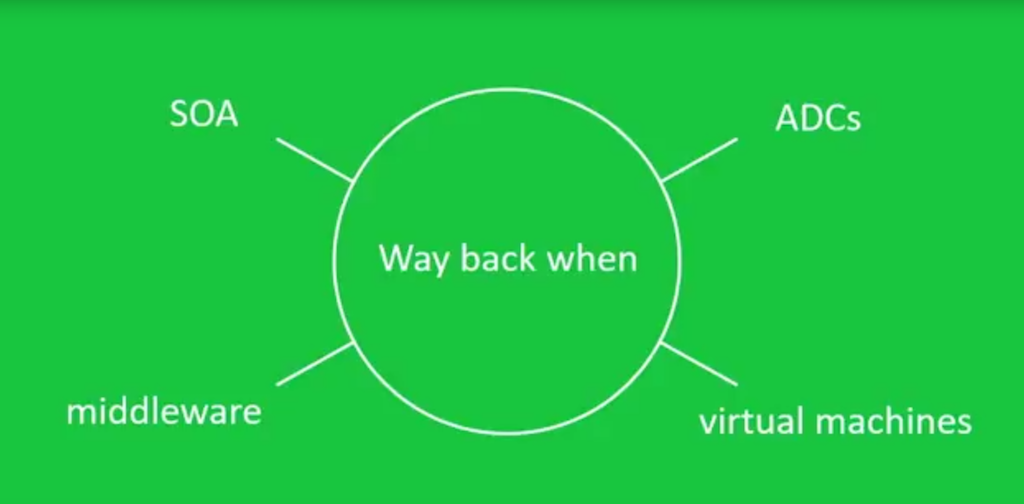
We were using hardware‑based application delivery controllers (ADCs) to help us accelerate those applications and scale them for the Internet, and for the Web as it was starting to become more prevalent. And, of course, we were all excited about virtual machines and how we could get greater utilization out of our compute resources. These were the times we were living in. And these were good times. We knew what we were doing. Everything was somewhat stable.
And then all of a sudden the financial crisis hit in 2008. And with the financial crisis came these disruptors. What really paved the way for that? What incubated this environment so that these innovators could be created? Well, I don’t think there was any single one thing, but there were a number of things I think got us to where we are today.
The first, of course, is the cloud, and we all know that. The cloud became mainstream. It provided compute resources, storage, and network at an incredibly low cost, and with such convenience that people didn’t have to buy physical hardware servers or build their own data centers. Any person with an idea could build an application running on a compute resource for pennies an hour.
And then open source started becoming prolific and ubiquitous and not just the operating system – as I mentioned before, I used to work at Red Hat – it went beyond the operating system. It moved into databases, NoSQL databases, in‑memory databases, relational databases. We moved into open source tools for middleware, for application servers, application frameworks, for hypervisors, for automation tools, for orchestration platforms.

We’re now even seeing artificial intelligence and machine learning tools available in open source. You can actually build a whole application with a full stack from open source tools. New languages started to become not just frontend but backend as well – like JavaScript – which brought a whole new influx of developers into building full stack applications.
And as these applications came about, we started to see a new breed of rock stars. It wasn’t just musicians that were getting fame and attention. People who were building applications that were changing the world were getting an equal amount of attention.
People like Mr. Musk became revered, inspiring people to want to build the next application, to become the next industrialist. And we had shows like Silicon Valley and The Big Bang Theory that are taking smart, technical people and making them a part of our popular culture. It’s changed the dynamics that we live in.
And then you can’t forget the mobile phone. People use their mobile phones in ways we never, ever thought. The reality is that they’re using them about four hours a day. And if you add that up over a year, that’s 60 days a year attached to your mobile phone.
Now if you don’t think these stats are true, do what I did and buy a bicycle. I bought a bicycle about a month ago. I can’t tell you how many times while I’m riding that bike – and I haven’t ridden a bike in almost ten years – I almost hit people who are walking and texting.
It’s gotten so bad that Hawaii has now banned walking and texting because people are getting hit. It’s dangerous. But people, whenever they have a spare second, are on their mobile phones and texting or playing with their applications.
And it’s a leisure device. You don’t see it now as a burden or a tool, you see it as something you want to spend your time on when you have a spare moment – to visit an application, to see pictures of your family, to see what your friends are up to. It’s actually a leisure device. So people want tools and applications on their phones.
And I think probably the biggest disruptor of all was what the financial crisis created: a change in interest rates that meant that investors couldn’t get a great return on their money putting money into stocks or bonds. They started to look at alternative areas of investment, and a lot of money flowed into venture capital.

If you look at what’s happened in venture capital, for the last 4 years we’ve had over $40 billion a year being funded into venture capital.
What does all that money go into? That money goes into people building a new app, a new idea, trying to disrupt an existing business. If you look at private equity, private equity currently has over $700 billion of dry powder, meaning money sitting in the bank waiting to be invested in the next idea.
There is so much cash available in the market for anybody with the next idea to build something that’s going to disrupt an existing industry today. When you put all these things together, you have this disruption. And so yes, we’ve experienced it.
My concern is that it only gets worse from here. With the amount of money that’s sitting out there, the tools that are available, the aspirations of people coming out of high school and college, we’re only going to see more disruption as we go along. So I wish I could tell you it’s going to get better.
So who experiences this first? I think the canary in the coal mine of what we’re experiencing was the retailers – retail shopping. We’ve already seen J.C. Penney shut down over 138 stores this year.
We’ve also seen Sears shut down, in the first half of the year, 180 stores. And now Sears announced a few weeks ago that they’re going to shut down another 150 stores between now and the end of the year. So, we’re seeing the retailers are already getting hit pretty hard.
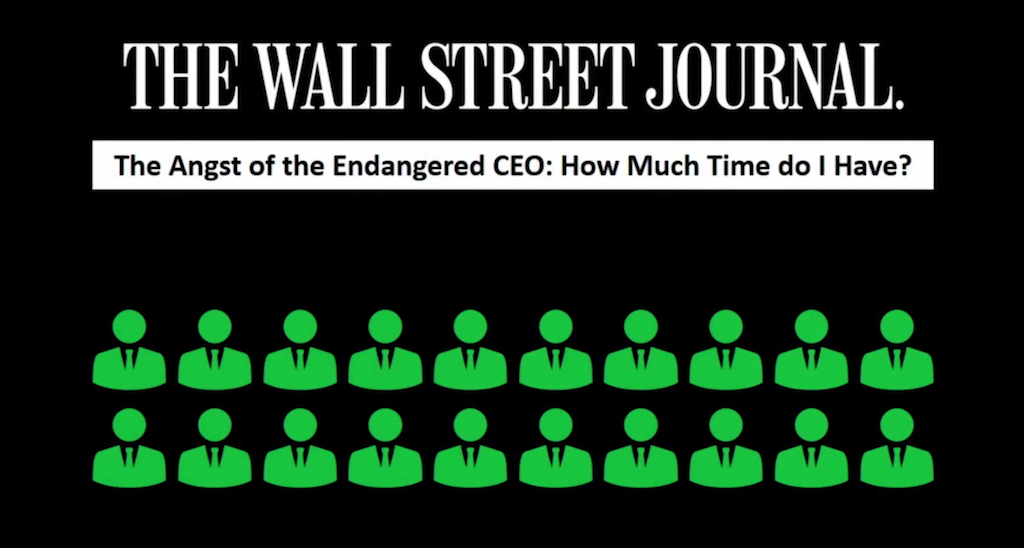
The Wall Street Journal also did a report in July where they analyzed 20 CEOs who had already left their companies in the first half of the year – and these are Fortune 500 companies – and there were three main causes: activist investors, industry disruption, or succession planning which was already in place.
Of the 20 that had already had left their company, 12 had left because of industry disruption, because of their inability to handle how disruption was impacting their company and transform it in a quick way.
So we’re seeing new applications coming about and they’re not hitting enterprises head‑on, they’re hitting them from the side. They’re hitting them at a thousand cuts per day rather than a head‑on collision.
So take Venmo: Venmo took a single pain point, microtransactions. Instead of trying to do a whole solution, they did microtransactions and made them very simple and very convenient, and at no cost to the consumer. And as a result, they’ve got a huge amount of adoption and they’ve been able to disrupt an entire industry. But traditional banks are not taking it easily. Wells Fargo has already come out with their own application called Zelle to compete.
The Age of Self-Disruption
So, we’re in this situation: most people think we need to either adapt or potentially die. Well, I think there’s a different approach that we’re seeing in the market, something that’s being much more successful.

Rather than adapt or die, we’re entering the age of self‑disruption. And these are the four models I mentioned earlier where we’re seeing companies be successful. Let me just take you through the four different models.
-
The first I call the Redirect. A great example is Macy’s. If you look at Macy’s, they’ve already shut down 16% of all their stores over the last 3 years. What that’s done is freed up over $550 million in cash that they’ve been able to redirect into their ecommerce and digital strategy.

They’ve added another $250 million to that, to give them $800 million to redirect into their digital strategy, to do both ecommerce and bring digital experiences into the stores where they want to keep and maintain them. So this is The Redirect: redirect your resources into the digital transformation.
-
The second is the Self‑Compete. This is a very interesting model. The example here is ADP. ADP has created a separate company, 100% owned by ADP, called Lifion. And Lifion was designed to be able to compete with new entrants into the market like ZenPayroll, which has now changed its name to Gusto.

And rather than trying to incubate that internally within the company with the existing culture, the distant existing processes and supply chain which – I’m sure many of you experienced – slow you down dramatically, they set this up as a completely separate company with its own payroll, its own culture, its own supply chain, so that it could innovate faster and bring new technologies in and a completely different culture.
And they place their offices in areas where there are startups, like in midtown New York, so they could attract the best talent. And so they’re building applications in the human capital management space to compete with their own applications, and so far it’s looking very successful.
-
The third model we’re seeing is the DNA Merger. The example we’re using here is Under Armour. If you look at Under Armour, they wanted to bring more technology capabilities into their apparel brand, so they acquired three companies: MapMyFitness, MyFitnessPal, and a European fitness company called Endomondo.

For those three companies combined they paid $715 million. What they acquired there, though, was a community of 120 million fitness enthusiasts whom they could now communicate with and sell their brand to. Not only did they do that, but as they bring in new technologies that link customers to their brand (like a sensor in their shoes), they can tell those users when they’ve run a certain amount of miles that mean those shoes should be replaced. And then they can encourage them to buy a new pair of Under Armour shoes.
So they’re bringing technology into their apparel brand and buying an audience to sell to, and now that audience over the last 3 or 4 years has now grown to over $200 million. So that’s been successful for them.
-
And the final – which I think is one of the more interesting of the four – is what I call the Spin Out. And the example we’re going to use here is Major League Baseball. MLB wanted to stream their own baseball games “over the top“, using the Internet, directly to consumers. So they created their own service.

And it was so successful that other companies approached them to get help on building their services, their over‑the‑top services as well, companies like HBO, World Wrestling Entertainment, ESPN. It was so successful that they spun the company out as a separate entity and attracted new investors. Originally, Disney came in and bought a 33% share for $1 billion.
More recently, they’ve upped their investment with an additional $1.5 billion to get a 75% share. If you look at that now, that separate entity is worth over $3 billion.
And if you look at what that represents to the 30 baseball teams that are part of MLB, that represents over $85 million per baseball team in returns that they got from a new entity that they created inside MLB and then spun out as a separate company. And they maintain, still, 15% ownership of that company, which is BAMTech.
What Might Slow You Down
So we live in a period of very fast times and we’ve got to move forward and deliver killer digital experiences. And speed to market is everything – it’s the difference between winning and losing.
So you want to move fast. We all know that; I don’t think I’m telling you anything you don’t know. But the question that we face now is: what’s going to slow you down? What are the things that are going to inhibit you being as fast as you want to be, or need to be, to be successful?
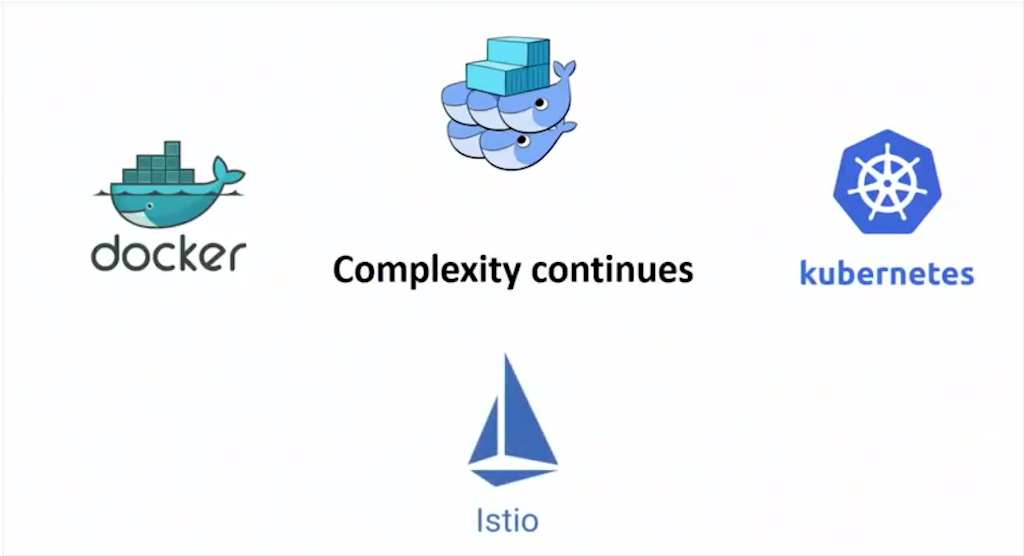
Number one is: the complexity continues as you roll out these new applications. Just think about containers. Containers was the hype de jour probably two years ago. And it was all about Docker and registries. And that transitioned into the next phase that we’ve seen over the last, I think, 12 or 18 months, which is around the orchestration platforms.
It became about Swarm and Kubernetes. I would argue we’re now at the third evolution of this container lifecycle. And the third evolution is service mesh (which is where we really should have started from), which is how applications actually run on container platforms. How do you get them to talk and connect?
This is what we’ve been worried about and thinking about for several years now, and we announced our Microservices Reference Architecture for running microservices through a distributed application. But now this transitions into: how do I run this on a containerized orchestrated platform? I think we’re in the third phase of the container lifecycle.
The second thing you need to be successful is: there’s so much data that’s available now. I mean, just think of the amount of data you can get out of a web server, load balancer, or your application about all the traffic flowing in and out. But what do you do with that data? Data is useless if it doesn’t somehow give you intelligence, and from that intelligence you can take action.
And so we have to transition from just being about gathering data to being intelligent about how we use that data and create, potentially, automation from that.

This is also one of the incredibly exciting parts of what we’re experiencing. People used to talk about the Internet of Things, and used to think an Internet thing was a fridge. No. I mean, Internet things are actually things like a self‑driving car, right?
And just think: a self‑driving car creates over 10 GB of data for every mile it travels. Are you going to connect that to the cloud and upload 10 GB every minute? It’s probably not realistic. You’re going to have processors in that car that are as powerful as a server. You’re going to have applications that have incredible intelligent logic, and you’re going to need a new range of operating systems, of application servers, and these things are not just going to have to connect back to the central database or central application in the cloud. They’re going to have, most likely, peer‑to‑peer communications, talking to each other.
How does that add complexity to your application over time? These effectively become additional services within your microservices architecture. And let’s not forget that you’ve still got to put 80% of your money and time and effort into running the existing applications you already have, before you get to build anything new.
And so you’ve got to still focus on keeping the lights on and how to move those existing applications forward into this new era of modern applications. Those cannot be left behind. In fact, you would mostly want to integrate those into your new applications so you get value out of those investments.
What Is NGINX Doing to Help?
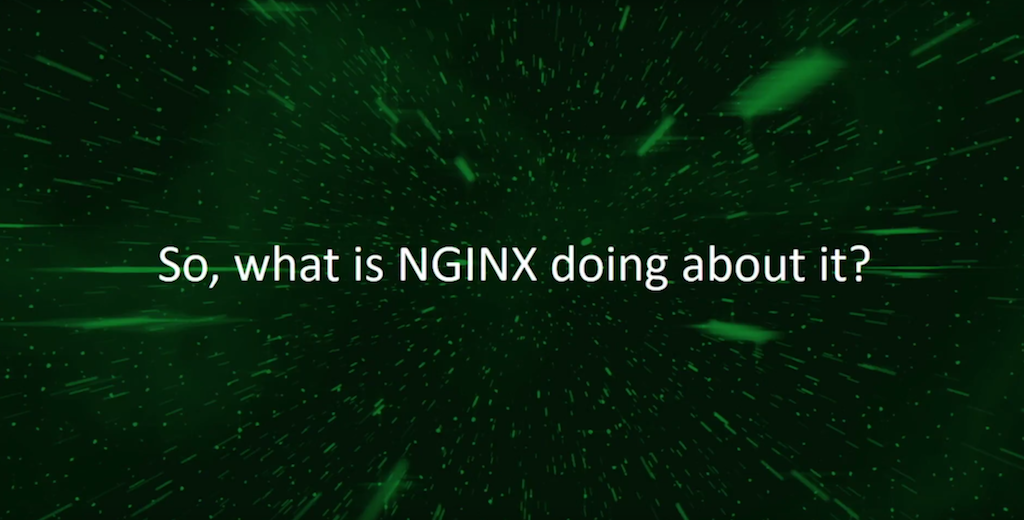
“So that’s all good news, Gus. Okay, thanks. You’ve told me about four success models. You’ve told me about the complexity of areas where you’re going to face stumbles or obstacles along the way. Well, what’s NGINX going to do about that?”
I’m glad you asked.
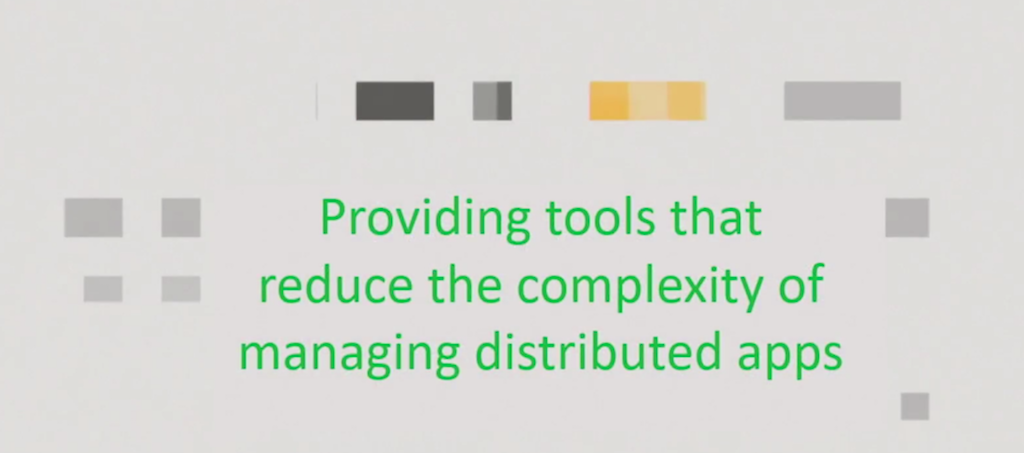
We’re going to be providing tools that help you reduce the complexity of managing your applications, particularly applications that are running distributed across containers and virtual machines. We’re going to bring you tools that help you move those legacy apps forward into your modern application architecture so that they’re not left behind.
We’re going to provide tools that help you scale your application, whether you’re running 10 users, 10 million users, or 100 million users or more. We’re going to help you build applications that scale. We’re going to bring intelligence to those applications.
And when I say intelligence, I don’t mean data, I mean analytics: information that you can use, that’s actionable, that can actually help you automate and have applications be self‑managed rather than requiring you to manage them. And, of course, these tools are all built on the core of open source, which is fundamental to what NGINX is.
The NGINX Application Platform Supports Adaptive, Modern Apps
So this has been our focus, and today is an incredibly exciting day for us here at NGINX. It’s the culmination of many years of work across multiple teams within the company, and I’m incredibly proud to be able to announce today the NGINX Application Platform.
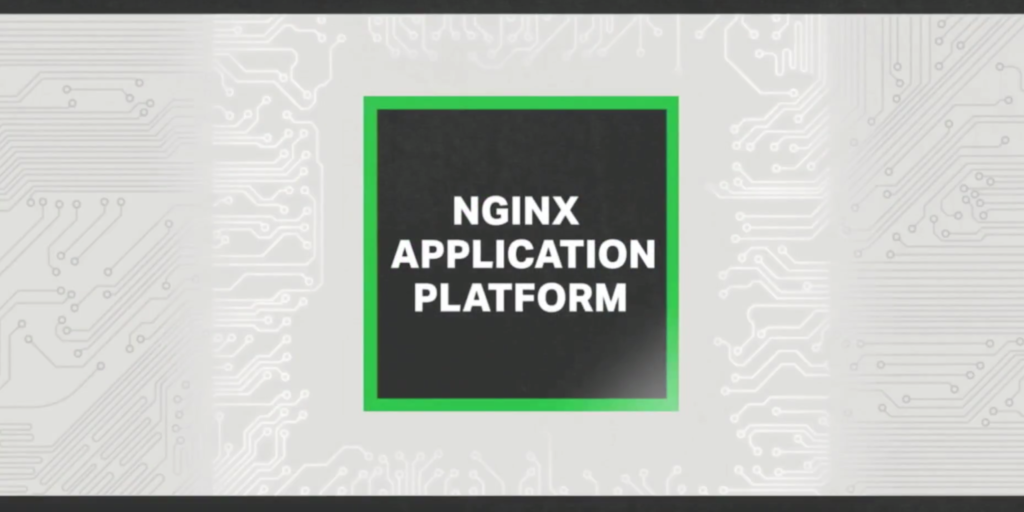
Thank you. I know you want to hear more, but I’m going to save that for Owen. What I do
want to tell you is our vision. Our vision with the NGINX Application Platform is that an application should be like a living organism. An application should be able to grow or shrink based on the environment it’s in. An application should be able to self‑heal if it’s broken.
An application should be able to defend itself if it’s being attacked. And an application should be able to spawn additional instances of the application as needed, creating new organisms.
This is our vision for the NGINX Application Platform. And if we’re successful in our vision, you’ll be able to move from worrying about the disruption that’s coming, and you’ll be able to move beyond the day‑to‑day of managing your application and getting that dreaded page in the middle of the night.
If we’re successful in our vision, you’ll be able to move forward and focus on bringing out new applications and new features in your application that actually help you drive exponential growth rather than just improve time to market.
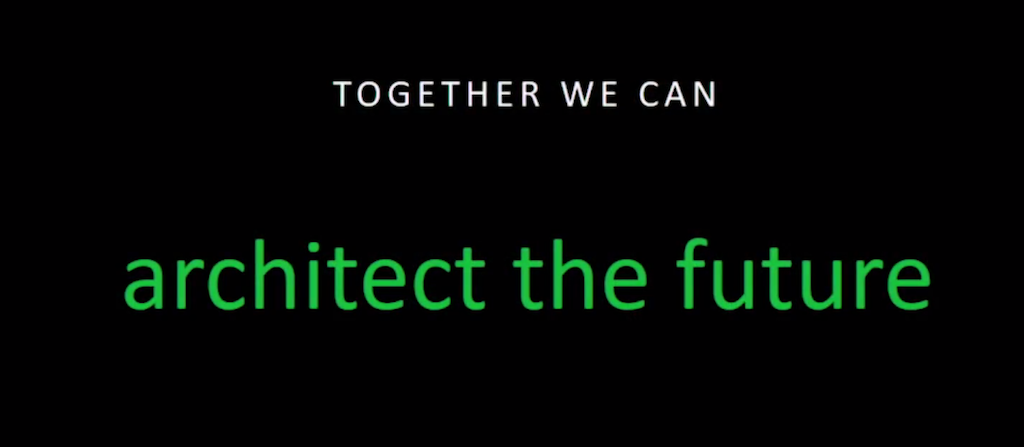
So together, what we’re aiming to do here is to architect the future. And we believe these tools that we’re announcing today are going to help us all do this in a very successful way moving forward.
I’d like to thank you all once again for being here. I sincerely appreciate the community we’ve built here at NGINX – with our customers, and our users, and our sponsors here that are part of our ecosystem, and also with our staff.
I do want to apologize – I have to leave, unfortunately, after the keynotes this morning. As some of you may know, I live in Miami and my family is still there, and Hurricane Irma is on its way, so we need to clear out. And the only flight we could get out of Miami is first thing tomorrow morning.
And so, in every other keynote, I’ve mentioned my daughter and usually I show Sofia the First, which is her favorite TV show. But I don’t have that today, I just have a photo of Chloe. She looks just like me, right?
So guys, this is so exciting and so incredibly important for NGINX. Thank you so much for being here. You’re going to have a great two days of content.


